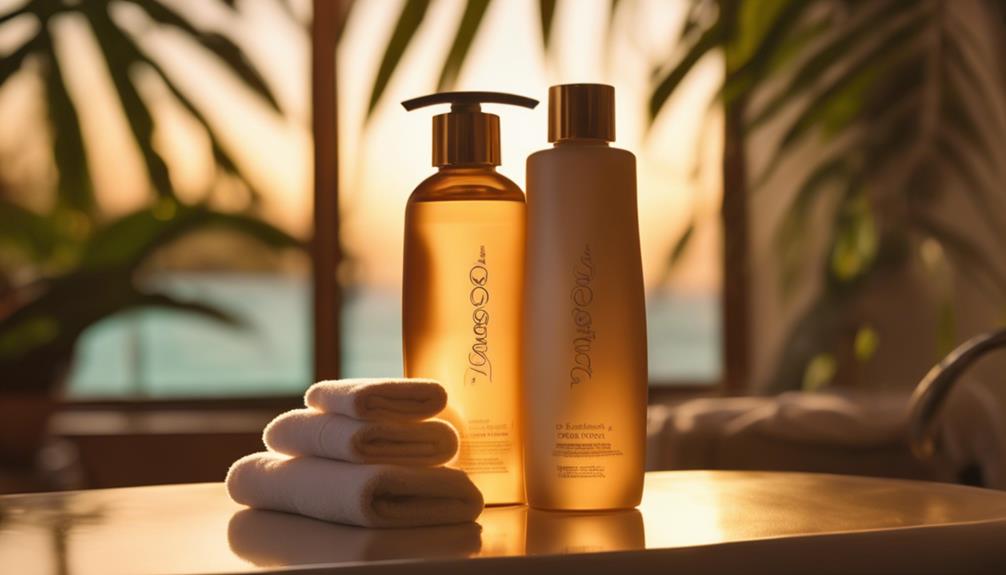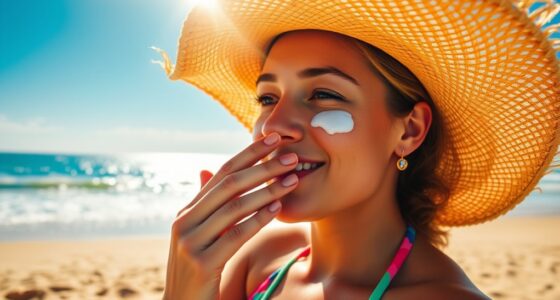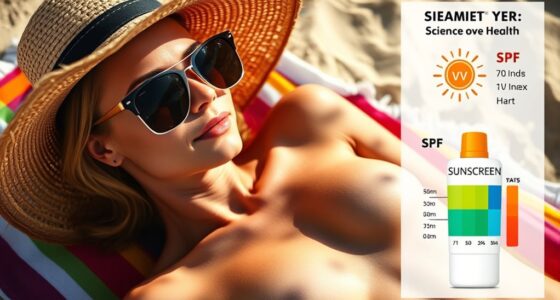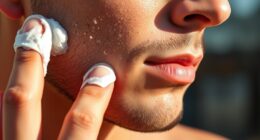Your skin truly remembers every sunburn, storing memories that can lead to aging signs and increased cancer risk. When you get sunburned, your skin accumulates UV damage, which may not show visible signs for years. Thankfully, breakthroughs in skincare can help erase these effects. New treatments focus on repairing DNA damage and rejuvenating skin appearance, enhancing texture and tone. Consistent use of sunscreen and protective clothing also plays an essential role in preventing further damage. Discovering effective strategies can empower you to take control of your skin's health and future. Curious about the latest innovations? You'll find more intriguing insights ahead.
Key Takeaways
- Consistent use of broad-spectrum sunscreen (SPF 30+) protects against cumulative UV damage and reduces skin cancer risk.
- Advanced treatments like retinoids, antioxidants, and laser therapies can rejuvenate sun-damaged skin and improve texture.
- Research into DNA repair mechanisms aims to reverse genetic damage caused by UV exposure.
- Regular dermatological check-ups facilitate early detection and intervention for precancerous skin changes.
The Science of Skin Memory
Skin memory is the term that describes how your skin retains a record of past sun exposure, leading to lasting effects like accelerated aging and an increased risk of skin cancer. This memory forms largely due to cumulative UV radiation, which causes both direct and indirect DNA damage in your skin cells.
Over time, these mutations can accumulate, considerably raising your skin cancer risk, particularly for melanoma. Even if you think one blistering sunburn during your youth won't affect you, studies reveal it can double your chances of developing melanoma later in life. This is especially true for fair-skinned individuals who've less melanin, leaving them more vulnerable to UV damage.
It's essential to understand that skin memory isn't just about the burns you can see; it involves a long-term record of every sun exposure. That's why practicing sun protection is vital. Regularly applying broad-spectrum sunscreen, wearing protective clothing, and seeking shade can help mitigate the risks associated with skin memory.
Lasting Effects of Sunburn

Sunburn doesn't just hurt in the moment—it leaves lasting effects that can haunt your skin for decades.
Every time you experience a sunburn, you're not just damaging your skin temporarily. Instead, you're setting yourself up for a host of long-term issues. Here are four key lasting effects of sunburn you should know:
- Cumulative Skin Damage: Each sunburn adds to your skin's damage, increasing the risk of developing skin cancer over time.
- Altered Skin Cells: UV radiation from sunburn can change your skin cells' DNA, potentially leading to abnormal growth and tumors.
- Premature Aging: The cumulative impact of sunburn accelerates the signs of aging, like wrinkles and age spots, making your skin look older than it is.
- Increased Sensitivity: Your skin remembers past sunburns, which can heighten its sensitivity to future UV exposure, making it more vulnerable to damage.
Understanding these lasting effects emphasizes the importance of consistent sun protection.
Protect your skin now to minimize the risk of serious problems later.
Breakthrough Treatment Revealed

Recent advancements in research are paving the way for breakthrough treatments that could reverse the lasting damage caused by sun exposure. Scientists have discovered specific genetic changes in skin DNA induced by UV exposure, which play a significant role in the development of skin cancer. By identifying these mutations, researchers are working toward early detection methods that could lead to timely intervention before visible damage occurs.
Ongoing studies, like those at Roswell Park, focus on deep-sequencing skin samples to reveal cancer-causing mutations. This approach may revolutionize how we perceive photoaging and cumulative damage from sunburns. Current treatments, such as retinoids and antioxidants, help rejuvenate skin and mitigate past sun exposure effects, but they don't address the core genetic damage.
The goal now is to develop medications that can halt or even reverse these detrimental changes. By enhancing prevention measures and targeting underlying genetic issues, these breakthrough treatments promise to protect your skin and potentially reduce the risk of skin cancer. You could soon have options that not only improve your skin's appearance but also erase the memory of those painful sunburns.
How Skin Damage Accumulates

You may not realize it, but each sunburn you get adds to your risk of long-term skin damage.
Cumulative exposure to UV rays can lead to serious changes in your skin, including an increased likelihood of skin cancer.
It's crucial to understand prevention and protection strategies to safeguard your skin's health now and in the future.
Cumulative UV Exposure Effects
Repeated exposure to UV rays accumulates over time, leading to lasting DNA damage in skin cells that greatly raises the risk of skin cancer. This cumulative UV exposure can have severe consequences, especially if you've experienced multiple sunburns.
Here are some key points to evaluate:
- Increased Risk: A history of five or more sunburns more than doubles the risk of developing melanoma later in life.
- Invisible Damage: Even without visible burns, chronic low-grade UV damage can persist for decades.
- Vulnerability: Fair-skinned individuals are particularly susceptible to cumulative UV damage, but all skin types can sustain harm.
- Early Detection: Specific UV-induced mutations in skin DNA can occur before any visible changes appear, stressing the need for protective measures.
To protect yourself, make sure to adopt sun safety habits.
Use broad-spectrum sunscreen daily, wear protective clothing, and seek shade during peak sun hours.
Remember, it's not just about avoiding sunburns; it's about preventing the cumulative UV exposure that leads to skin cancer in the long run.
Stay vigilant and proactive in caring for your skin!
Long-Term Skin Changes
Cumulative UV exposure not only raises the risk of skin cancer but also leads to long-term skin changes that can manifest as premature aging and other visible damage. Each time you experience sun exposure, whether it results in a blistering burn or not, your skin accumulates damage from UV radiation. This damage can alter your skin's DNA, leading to the development of damaged cells that may cause skin cancer over time.
You might notice signs of cumulative sun damage, like wrinkles, uneven skin tone, or spider veins, appearing as early as your teen years. These indicators of premature skin aging can be subtle at first but become more pronounced as years go by. Even chronic low-grade damage from everyday sun exposure contributes considerably to these issues, emphasizing the importance of consistent sun protection.
It's essential to recognize that accumulating sun damage doesn't just come from acute burns. Rather, it's the consistent exposure to UV radiation that plays a vital role in your skin's long-term health.
Taking proactive measures to protect your skin will help mitigate these changes and maintain a youthful appearance.
Prevention and Protection Strategies
Protecting your skin from sun damage requires consistent and proactive strategies to minimize the risk of long-term effects. Skin damage accumulates over time, increasing your risk of skin cancer with each sunburn. To effectively safeguard your skin, consider these essential prevention and protection strategies:
- Always use broad-spectrum sunscreen: Apply a broad-spectrum sunscreen with at least SPF 30 every day, even on cloudy days. Reapply every two hours, or more often if you're swimming or sweating.
- Wear protective clothing: Choose lightweight, long-sleeved shirts and wide-brimmed hats. Look for clothing with UV protection for added security against skin damage.
- Seek shade during peak hours: Limit sun exposure between 10 AM and 4 PM when UV rays are strongest. If you must be outdoors, find shade under trees or umbrellas.
- Practice sun safety year-round: Don't let your guard down in winter or on overcast days. UV rays can penetrate clouds, so consistent UV protection is vital.
Patient Transformations and Success Stories

You might be surprised to hear how many patients have turned their skin health around by adopting proactive sun protection and seeking timely treatments.
Their journeys show that with the right strategies, you can achieve significant improvements in your skin's appearance and overall health.
Let's explore some inspiring success stories that highlight these transformative outcomes.
Personal Healing Journeys
Through their personal healing journeys, many individuals have discovered the transformative power of sun-safe habits and regular skin check-ups. By adopting these practices, they not only protect their skin but also experience emotional healing.
Here are some key changes that have empowered many:
- Consistent Sunscreen Use: Applying broad-spectrum sunscreen daily has considerably reduced their risk of skin cancer and further sun damage.
- Regular Dermatological Check-ups: Early detection through routine check-ups has led to the identification and removal of precancerous lesions, enhancing their skin health.
- Lifestyle Adjustments: Seeking shade during peak sun hours and wearing protective clothing have been essential in their skin recovery journeys.
- Educational Empowerment: Many have embraced sun safety programs, enabling them to advocate for their own skin care and preventive measures.
These transformations highlight how prioritizing sun safety not only protects your skin but also fosters greater confidence and peace of mind.
As you start on your own healing journey, remember that each small step contributes to a brighter, healthier future for your skin.
Transformative Treatment Outcomes
Patients often experience remarkable transformations in their skin health after committing to tailored treatment regimens and sun-safe practices. Many have reported significant improvements in skin texture and tone by integrating retinoids and antioxidants into their routines. Success stories abound, showcasing how consistent use of broad-spectrum sunscreen with SPF 30+ effectively reduces sun damage and fine lines.
These transformations aren't just skin-deep. Patients also embrace lifestyle changes, such as wearing protective clothing and receiving regular dermatological care, which empower them in managing their skin health. Advanced laser therapies have been particularly transformative, targeting pigmented lesions from UV exposure.
Here's a glimpse into patient experiences:
| Treatment Type | Outcome | Patient Testimonial |
|---|---|---|
| Retinoids & Antioxidants | Improved texture & tone | "My skin feels rejuvenated!" |
| Broad-Spectrum Sunscreen | Reduced fine lines & sun damage | "I can finally enjoy the sun safely!" |
| Laser Therapy | Diminished pigmented lesions | "My confidence has soared!" |
| Protective Clothing | Enhanced skin health & empowerment | "I feel in control of my skin!" |
Your journey to transformative skin health starts with conscious choices!
The Role of Skin Cells

Skin cells, especially keratinocytes and melanocytes, play a vital role in both repairing UV damage and protecting against future sun exposure.
Keratinocytes in the epidermis are your skin's frontline soldiers, working tirelessly to repair any damage caused by UV radiation. Melanocytes, on the other hand, produce melanin to shield your skin from harmful rays. However, repeated sunburns can lead to mutations in these cells, increasing the risk of skin cancer.
Here are four key roles played by your skin cells:
- Repair Mechanism: Keratinocytes actively fix UV-induced damage, but excessive exposure can overwhelm this process.
- Melanin Production: Melanocytes generate melanin, which helps absorb and dissipate UV radiation.
- DNA Protection: Skin cells guard against DNA damage that can lead to abnormal cell growth and skin cancer.
- Memory of Damage: Even non-visible damage can persist in skin cells for decades, underscoring the need for consistent sun protection.
Understanding the roles of your skin cells can empower you to take proactive steps against UV damage and reduce the risk of long-term consequences.
Debunking Myths About Sun Damage

Many people mistakenly believe that only severe sunburns pose a risk for skin cancer, but even mild burns can accumulate harmful damage over time. If you've had five or more sunburns, your risk of developing skin cancer can increase markedly.
It's essential to understand that all skin types are susceptible to UV exposure. Don't fall for the misconception that darker skin doesn't need sunscreen; everyone should prioritize sun protection.
Another common myth is that sun damage only occurs during sunny days. In reality, up to 80% of UV rays can penetrate clouds, meaning you're still at risk even when it's overcast. Remember, the cumulative effects of UV radiation can lead to long-term skin changes, including premature aging and an increased likelihood of skin cancer.
You might think sunscreen is only necessary in summer, but you need year-round protection. Choose a broad-spectrum sunscreen with a sun protection factor (SPF) of 30 or higher and reapply it every two hours.
Future Innovations in Skin Care

As we uncover the truths about sun damage, it's exciting to see how future innovations in skincare are poised to repair and protect your skin from the harmful effects of UV exposure. Here are some promising advancements you can look forward to:
- Enhanced DNA Repair Mechanisms: New formulations aim to boost your skin's natural ability to repair damage from UV radiation, potentially reversing the effects of sunburns.
- Topical Treatments for Collagen Production: Ingredients like niacinamide and peptides are being researched to stimulate collagen production, improving skin elasticity and barrier function.
- Targeted Medications: Clinical trials are exploring medications that specifically target UV-induced mutations in skin DNA, helping to prevent progression to skin cancer.
- AI in Dermatology: The integration of artificial intelligence allows for personalized skincare regimens, tailoring treatments to your specific skin damage and needs.
With these innovations, skincare is evolving into a more precise science, addressing issues like photoaging while prioritizing your skin's overall health. Embrace the future, and you might just find ways to erase your skin's memory of sunburns.
Frequently Asked Questions
What Are Some Interesting Facts About Sunburns?
Sunburns can cause redness, swelling, and pain, and even one blistering sunburn in youth can double your melanoma risk. Remember, UV rays can penetrate clouds, so protection's essential, even on overcast days.
Did Ancient Humans Get Sunburn?
Yes, ancient humans definitely got sunburned. Even with their natural melanin, prolonged sun exposure could lead to skin damage. It's fascinating how their adaptations to UV light shaped our understanding of skin health today.
How Many Sunburns Does It Take to Get Skin Cancer?
It only takes five or more sunburns to considerably increase your risk of developing skin cancer. Even just one blistering sunburn during youth can double your chances later in life, so be cautious!
Do You Sunburn More Easily as You Get Older?
Ever noticed how your skin reacts differently to the sun as you age? You do sunburn more easily because your skin thins and produces less melanin, making it essential to prioritize sun protection now.
How Does Sunburn Affect Your Skin’s Memory and How Can You Erase It?
Sunburn can damage skin’s memory by increasing the risk of long-term skin issues. To erase the damage, consider using a skin eating makeup solution to help remove dead and damaged skin cells. This can help promote healthy skin regeneration and reduce the visible effects of sun damage.
Conclusion
Just like a tree bears the scars of storms, your skin holds onto every sunburn, etching memories deep within.
But don't worry; you can nurture your skin back to health, like tending to a garden after a harsh winter.
With innovative treatments and a little care, you can help erase those memories, allowing your skin to flourish anew.
Embrace the future of your skincare journey, and watch your skin transform into a vibrant, sun-kissed meadow once more.









